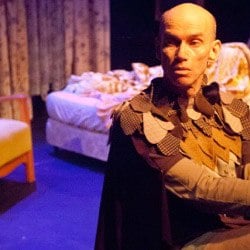
Image: Phyllis Wong
Home | Blog | What is to become of disciplinary purists?
What is to become of disciplinary purists?
When I first heard the Australia Council for the Arts was restructuring, including changing its assessment methodology, which would inadvertently favour interdisciplinary works, I was outraged. “What is to become of the disciplinary purists?”, I thought. This was accompanied by a vision of what seemed like an inevitable death knell of dance.
It wasn’t as if I was actually expressing myself through a single medium. I don’t think I really ever have, except if you count my early bread and butter corporate gigs, performed on readymade snap-together portable stages that saw action in front of (predominately) suits, accompanied by the din of careless wine glasses and heavy cutlery. (Phew, say that out loud in one breath). I suppose in hindsight I was incensed by the impending possibility of a diminished specialist option.
It is the meditation on my last week’s debut experience as director of a play, consisting of another’s words and not of my own devising, that has me revisiting my initial thoughts on the implications and impact of jumping the genre ship. In my case from the kinaesthetic to the oratory.
But before I gabble on about myself I’d like to refer to the event that served as an exclamation mark to my first theatrical directorial experience and that is Brian Carbee’s Perch. Perch unfolds each night in the cosy close quarters of the downstairs theatre at Belvoir as part of the official Gay and Lesbian Mardi Gras program. It’s a single-hander performed by Carbee, written and directed in conjunction with Sarah Carradine.
The play is written for two characters who speak directly to each other but only really ever interact through tormented visions and reimaginings of the past. One character is at once a man as a bird, a man of insignificant accomplishments, a solitary figure desperately seeking company, forced to comply to unorthodox instructions, laid out in a want add in a newspaper, to appease his (and later her) almost non-existent existence. The other character emerges half way through the play as a washed up woman of inconsequence, except for the fact that she is the instigator of the unique arrangement. Her action, a last bid invitation designed to appease a life devoid of intimacy.
The premise is complicated and ambiguous, consisting of a series of intricate inner unveilings of the psyche made plausible and palatable by Carbee’s kinaesthetic rendering. How else could a character be a man and simultaneously a bird of prey? For it is the melding of Carbee’s literary wit, coupled with his movement, which allows such abstract leaps. The movement acts as a live CGI component, helping us to realise the fantastic elements of this tale. We, the audience, are given a greater palette of interpretive options because the text is joined by abstract dots of dance sequencing. Is there just one character with multiple personalities on stage? Or two separate beings of equal emotional/psychological fragility?
At this point I must confess my bias. Brian is my latest and probably longest-lasting dance guru. He teaches a technique class peppered with a dry sardonic humour, encouraging us to find a psychological attachment to the purely physical. It is as if we are given the opportunity to carry on a one-and -a-half hour cross-disciplinary conversation. Our intent is honed through subtle bodily sequencing. This engagement is what enables me to withstand repetition; training consisting of constant meaning-finding. It is the consummate melding of the didactic with the abstract.
My review of Carbee’s Perch prompted me to think of other cross disciplinary artists utilising dance and I thought of visual artist David Capra who utilises movement scores to heal through absurdist light-hearted action. His movement installations appear as spontaneous outpourings of joy due to the candour of his delivery, rarely equalled by dance convention deployed through rigid phrasing.
As I prepare for my next rehearsal development I am buoyed by the challenges of a cast consisting of both dancers and actors. I am inspired by the patience and generosity my cast share for one another and for the already explicit trust they have demonstrated as they take on my relatively unconventional approach. I am learning to be more sensitive to a collaborative engagement that may take unexpected turns, to hopefully produce an exciting outcome, due to genre deviations and slippages.
Brian Carbee’s Perch runs ’til Sunday the 21st of Feb. (Watch this space for more inside insights from my directorial debut of Jane Harrison’s Stolen in June).
-Vicki Van Hout

